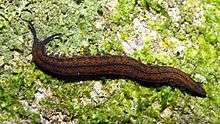Peripatoides
Peripatoides is a genus of velvet worms in the Peripatopsidae family. These animals are nocturnal hunters that spit glue to trap their prey. In New Zealand species of Peripatoides have 14, 15 or 16 pairs of legs.[1] Female Peripatoides produce eggs that are fertilized internally and babies develop inside their mother until large enough to be born, in batches of 4-6, as colourless miniatures of the parents[1].
| Peripatoides | |
|---|---|
 | |
| Scientific classification | |
| Kingdom: | |
| Phylum: | |
| Class: | |
| Order: | |
| Family: | |
| Genus: | Peripatoides Pocock, 1894 |
| Species | |
|
See text | |
Species
The genus contains the following species:[2]
- Peripatoides indigo Ruhberg, 1985
- Peripatoides kawekaensis Trewick, 1998
- Peripatoides suteri Dendy, 1894
The ovoviviparous (live-bearing) taxon with 15 pairs of legs from New Zealand, Peripatoides novaezealandiae (Hutton 1876), is a species complex of at least five reproductively isolated taxa described in 1998.[3] These new species (Peripatoides aurorbis, Peripatoides kawekaensis, Peripatoides morgani and Peripatoides sympatrica Trewick, 1998) have no morphological characters that distinguish them although they are genetically differentiated.[4][3] Peripatoides novaezealandiae (Hutton, 1876), and the cryptic species are considered nomina dubia by Oliveira et al., 2012 because type locations were identified not holotype specimens. There is debate about whether a species name should be recognized if a whole dead specimen is not held in a museum[5] [6].
In 2014 the New Zealand Department of Conservation also recognized[7]:
- Peripatoides novaezealandiae (Hutton, 1876)
- Peripatoides aurorbis Trewick, 1998
- Peripatoides morgani Trewick, 1998
- Peripatoides sympatrica Trewick, 1998
References
| Wikimedia Commons has media related to Peripatoides. |
- Trewick, Steven (2019). Wild Life New Zealand. New Zealand: Hand-in-Hand Press. ISBN 978-0-473-48320-3.
- Oliveira, I. S.; Read, V. M. S. J.; Mayer, G. (2012). "A world checklist of Onychophora (velvet worms), with notes on nomenclature and status of names". ZooKeys (211): 1–70. doi:10.3897/zookeys.211.3463. PMC 3426840. PMID 22930648. Retrieved 16 July 2016.
- Trewick, Steven A. (1998). "Sympatric cryptic species in New Zealand Onychophora". Biological Journal of the Linnean Society. 63 (3): 307–329. doi:10.1111/j.1095-8312.1998.tb01520.x. ISSN 0024-4066.
- Trewick, S. A. (2000). "Mitochondrial DNA sequences support allozyme evidence for cryptic radiation of New Zealand Peripatoides (Onychophora)". Molecular Ecology. 9 (3): 269–281. doi:10.1046/j.1365-294x.2000.00873.x. ISSN 1365-294X. PMID 10736025.
- Donegan, Thomas M. (2008). "New species and subspecies descriptions do not and should not always require a dead type specimen". Zootaxa. 1761 (1): 37–48. doi:10.11646/zootaxa.1761.1.4. ISSN 1175-5334.
- Peterson, A. Townsend (2014). "Type specimens in modern ornithology are necessary and irreplaceableLos especímenes tipo en la ornitología moderna son necesarios e irremplazablesType specimens in modern ornithology". The Auk. 131 (3): 282–286. doi:10.1642/AUK-13-204.1. ISSN 0004-8038.
- New Zealand peripatus/ngaokeoke : current knowledge, conservation and future research needs. New Zealand. Department of Conservation, New Zealand. ISBN 9780478150094. OCLC 994631114.CS1 maint: others (link)
- New Zealand Department of Conservation (2014) New Zealand peripatus/ngaokeoke: Current knowledge, conservation and future research needs. Dunedin: Department of Conservation. ISBN 978-0-478-15009-4
- Trewick, S. A. (1998). "Sympatric cryptic species in New Zealand Onychophora". Biological Journal of the Linnean Society. 63 (3): 307–329. doi:10.1111/j.1095-8312.1998.tb01520.x.
- Trewick, S. A. (2000). "Mitochondrial DNA sequences support allozyme evidence for cryptic radiation of New Zealand Peripatoides". Molecular Ecology. 9: 269–281. doi:10.1046/j.1365-294x.2000.00873.x. PMID 10736025.